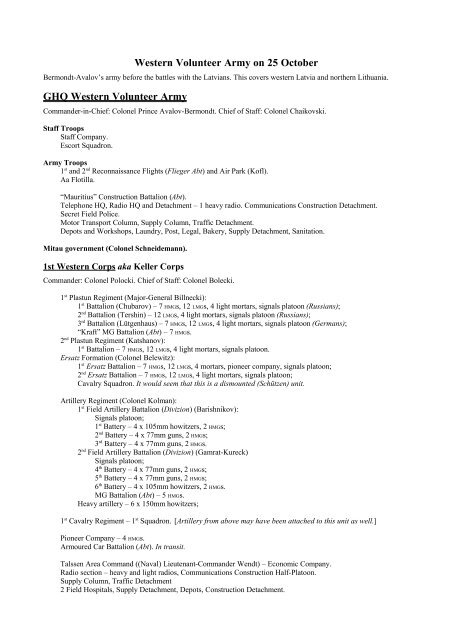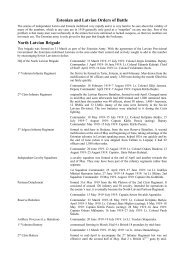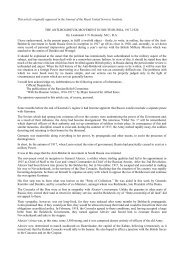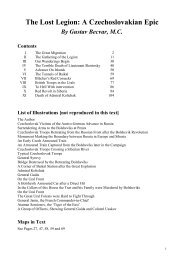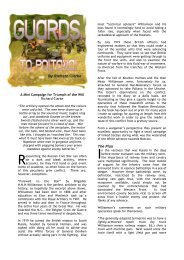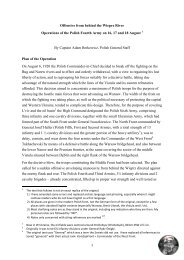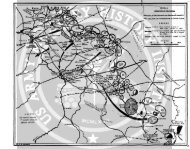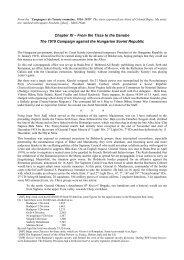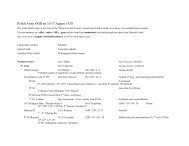German Order of Battle before Riga - Pygmy Wars Home
German Order of Battle before Riga - Pygmy Wars Home
German Order of Battle before Riga - Pygmy Wars Home
Create successful ePaper yourself
Turn your PDF publications into a flip-book with our unique Google optimized e-Paper software.
Western Volunteer Army on 25 October<br />
Bermondt-Avalov’s army <strong>before</strong> the battles with the Latvians. This covers western Latvia and northern Lithuania.<br />
GHQ Western Volunteer Army<br />
Commander-in-Chief: Colonel Prince Avalov-Bermondt. Chief <strong>of</strong> Staff: Colonel Chaikovski.<br />
Staff Troops<br />
Staff Company.<br />
Escort Squadron.<br />
Army Troops<br />
1 st and 2 nd Reconnaissance Flights (Flieger Abt) and Air Park (K<strong>of</strong>l).<br />
Aa Flotilla.<br />
“Mauritius” Construction Battalion (Abt).<br />
Telephone HQ, Radio HQ and Detachment – 1 heavy radio. Communications Construction Detachment.<br />
Secret Field Police.<br />
Motor Transport Column, Supply Column, Traffic Detachment.<br />
Depots and Workshops, Laundry, Post, Legal, Bakery, Supply Detachment, Sanitation.<br />
Mitau government (Colonel Schneidemann).<br />
1st Western Corps aka Keller Corps<br />
Commander: Colonel Polocki. Chief <strong>of</strong> Staff: Colonel Bolecki.<br />
1 st Plastun Regiment (Major-General Billnecki):<br />
1 st Battalion (Chubarov) – 7 HMGs, 12 LMGs, 4 light mortars, signals platoon (Russians);<br />
2 nd Battalion (Tershin) – 12 LMGs, 4 light mortars, signals platoon (Russians);<br />
3 rd Battalion (Lütgenhaus) – 7 HMGs, 12 LMGs, 4 light mortars, signals platoon (<strong>German</strong>s);<br />
“Kraft” MG Battalion (Abt) – 7 HMGs.<br />
2 nd Plastun Regiment (Katshanov):<br />
1 st Battalion – 7 HMGs, 12 LMGs, 4 light mortars, signals platoon.<br />
Ersatz Formation (Colonel Belewitz):<br />
1 st Ersatz Battalion – 7 HMGs, 12 LMGs, 4 mortars, pioneer company, signals platoon;<br />
2 nd Ersatz Battalion – 7 HMGs, 12 LMGs, 4 light mortars, signals platoon;<br />
Cavalry Squadron. It would seem that this is a dismounted (Schützen) unit.<br />
Artillery Regiment (Colonel Kolman):<br />
1 st Field Artillery Battalion (Divizion) (Barishnikov):<br />
Signals platoon;<br />
1 st Battery – 4 x 105mm howitzers, 2 HMGs;<br />
2 nd Battery – 4 x 77mm guns, 2 HMGs;<br />
3 rd Battery – 4 x 77mm guns, 2 HMGs.<br />
2 nd Field Artillery Battalion (Divizion) (Gamrat-Kureck)<br />
Signals platoon;<br />
4 th Battery – 4 x 77mm guns, 2 HMGs;<br />
5 th Battery – 4 x 77mm guns, 2 HMGs;<br />
6 th Battery – 4 x 105mm howitzers, 2 HMGs.<br />
MG Battalion (Abt) – 5 HMGs.<br />
Heavy artillery – 6 x 150mm howitzers;<br />
1 st Cavalry Regiment – 1 st Squadron. [Artillery from above may have been attached to this unit as well.]<br />
Pioneer Company – 4 HMGs.<br />
Armoured Car Battalion (Abt). In transit.<br />
Talssen Area Command ((Naval) Lieutenant-Commander Wendt) – Economic Company.<br />
Radio section – heavy and light radios, Communications Construction Half-Platoon.<br />
Supply Column, Traffic Detachment<br />
2 Field Hospitals, Supply Detachment, Depots, Construction Detachment.
2 nd Western Corps aka Virgolich Corps<br />
Commander: Colonel Virgolich.<br />
Signals Platoon<br />
1 st Officers MG Company – ? HMG<br />
1 st Rifle Regiment:<br />
1 st Battalion – 16 HMGs (in 2 companies), 16 light mortars;<br />
2 nd Battalion (von Petersdorff) – 12 HMGs (in 2 companies), 16 light mortars, bicycle platoon.<br />
1 st Cavalry Regiment<br />
1 st Squadron – 4 HMGs;<br />
2 nd Squadron;<br />
3 rd Squadron;<br />
Cavalry Platoon “von Petersdorff”.<br />
1 st Artillery Regiment:<br />
1 st Battery – 4 x 105mm howitzers;<br />
2 nd Battery – 4 x 105mm howitzers;<br />
Battery attached to Infantry Group “von Petersdorff” – 2 x 105mm howitzers.<br />
2 nd Pioneer Company.<br />
Reconnaissance Flight (Flieger Abt) – 6 planes.<br />
Mounted Police Squadron.<br />
Motor Transport, 3 Supply Columns.<br />
Economic Company, Field Hospital.<br />
Iron Division<br />
Commander-in-Chief: Major Bisch<strong>of</strong>f. Chief <strong>of</strong> Staff: Captain Biese.<br />
1 st Infantry Regiment (Major von Lossow) – 2 HMGs (<strong>German</strong>s):<br />
1 st Battalion (Krüger) – 13 HMGs, 13 LMGs, signals platoon;<br />
2 nd Battalion (von der Groeben) – 15 HMGs, 14 LMGs, 6 light mortars;<br />
3 rd Battalion (von Stülpnagel) – 15 HMGs, 12 LMGs, 4 light mortars.<br />
2 nd Infantry Regiment (Major von Bomhard) – 2 HMGs (Austrians):<br />
1 st Battalion (von Lieberman) – 8 HMGs, 30 LMGs, signals platoon;<br />
2 nd Battalion (Balla) – 9 HMGs, 15 LMGs, 6 light mortars;<br />
3 rd Battalion (Berthold) – 14 HMGs, 3 LMGs;<br />
4 th Battalion (Captain) – 6 HMGs.<br />
3 rd Infantry Regiment (Captain Kiewitz) – ? HMGs (3 <strong>German</strong>s and 1 Bavarians):<br />
1 st Battalion (Meerwein) – 8 HMGs, 30 LMGs, signals platoon;<br />
2 nd Battalion (Wolten) – 9 HMGs, 15 LMGs, 6 light mortars;<br />
3 rd Battalion (Rieckh<strong>of</strong>f) – 12 HMGs, 3 LMGs;<br />
MG Battalion –3 companies each <strong>of</strong> 6 HMGs.<br />
Jäger Battalion (Lieutenant Büchner) – 8 HMGs, 13 LMGs, 2 light mortars, 4 field guns.<br />
MG Marksman Battalion (Abt) – four companies <strong>of</strong> 6 HMGs each.<br />
Cavalry Regiment (Major Count Kanitz) – ? HMGs, ? LMGs:<br />
1 st Squadron (Doin) – 1 HMG, 1 LMG;<br />
2 nd Squadron (von Ramin);<br />
3 rd Squadron (von Rheden);<br />
4 th Squadron (Meyer);<br />
5 th Squadron (von <strong>Home</strong>yer).<br />
Artillery HQ (Major Sixt von Arnim).<br />
Field Artillery Regiment – 1 LMG + 2 HMGs with transport:<br />
1 st Battalion (Auerbach) – 1 LMG:<br />
1 st Battery – 4 x 77mm guns, 2 HMGs;<br />
2 nd Battery – 4 x 105mm howitzers, 2 HMGs.<br />
2 nd Battalion (von Hake) – 2 LMGs:<br />
4 th Battery – 4 x 77mm guns, 2 HMGs;
5 th Battery – 4 x 105mm howitzers, 2 HMGs.<br />
3 rd Battalion (Schenk):<br />
7 th Battery – 4 x 77mm guns, 2 HMGs;<br />
9 th Battery – 4 x 77mm guns, 2 HMGs.<br />
Munitions Column.<br />
Heavy Artillery Battalion:<br />
“Baden” Battery – 1 x 105mm gun, 2 x 150mm howitzers, 1 HMG;<br />
“Feuerherd” Platoon – 2 x 105mm guns.<br />
Pioneers (Captain Damitz):<br />
1 st Company – 2 HMGs, 4 LMGs;<br />
2 nd Company – 2 HMGs, 4 LMGs;<br />
Bridge building Battalion (Abt) – 1 LMG;<br />
Pontoon train – 2 HMGs.<br />
429 th Reconnaissance Flight (Flieger Abt).<br />
Armoured Car Battalion (Abt) – 4 cars, 10 HMGs, 6 LMGs, 1 x 76.2mm gun (Russ), 2 x 105mm howitzers.<br />
River Flotilla.<br />
Rear Echelon HQ (Cavalry Captain von der Lancken)<br />
Police Battalion (Fuhrmann) – 2 HMGs, 8 LMGs.<br />
Iron Div. Gendarme Troop.<br />
Railway Protection Company Mitau – 4 HMGs, 4 LMGs.<br />
9 Town Kommandanturen.<br />
Ersatz Depot Unit – 1 HMG, 4 LMGs.<br />
Radio and Telegraph – 1 heavy radio, 1 light radio, telegraph.<br />
Motor Transport, 2 Supply Columns (4 LMGs), Traffic Company.<br />
Economic Company, 2 x Field Hospitals, Ambulance Unit, Bakery, Butchery, Vet.<br />
<strong>German</strong> Legion<br />
Commander: Ship’s Captain Sievert. Chief <strong>of</strong> Staff: Captain Wagener.<br />
Staff Company.<br />
Volunteer Cavalry Platoon.<br />
“Worter” Signals Company + Signals Platoon.<br />
Infantry HQ (Major Götze)<br />
Baden Assault Battalion – 1 HMG, ? LMGs, signals platoon;<br />
Baltenland Regiment – 5 companies, 8+ HMGs, 6 light mortars, signals platoon;<br />
“von Weickhmann” Detachment – 2 battalions, 2 LMGs, 18 HMGs, signals platoon;<br />
“Damm” MG Marksman Battalion (Abt);<br />
“von Jena” Battalion (Abt) – 2 battalions, 3 HMGs, signals platoon;<br />
“von Brandis” Detachment – 2 battalions, 4+ HMGs, signals platoon.<br />
“von Medem” MG Battalion (Abt) – 2 companies, 18 HMGs, signals platoon;<br />
“Stever” MG Detachment – 2 companies, 14 HMGs, signals platoon.<br />
Cavalry<br />
“von Brandis” Squadron.<br />
“Baltenland” Squadron.<br />
“von Weickhmann” Squadron.<br />
Artillery (Major Mielentz)<br />
“von Medem” Group:<br />
Battery – 4 x 77mm guns;<br />
Battery – 2 x 77mm guns.<br />
“von Brandis” Group:<br />
1 st Battery – 2 x 77mm guns;<br />
2 nd Battery – 1 x 105mm howitzer;<br />
3 rd Battery – 2 x 77mm guns.<br />
“Stever” Group:<br />
1 st Battery – 4 x 77mm guns;<br />
2 nd Battery – 4 x 105mm howitzers;<br />
3 rd Battery – 4 x 105mm howitzers.<br />
“von Weickhmann” Group:
1 st Battery – 2 x 105mm howitzers;<br />
2 nd Battery – 4 x 77mm guns;<br />
3 rd Battery – 4 x 77mm guns.<br />
“von Jena” Group:<br />
Battery – 4 x 77mm guns;<br />
Battery – 4 x 77mm guns;<br />
Battery – 2 x 37mm guns.<br />
“Schröder” Battery – ? 150mm howitzers.<br />
2 nd Air Division (Flieger Division).<br />
Armoured Train “Siewert”.<br />
Gendarme Battalion (Abt).<br />
Motor Transport, 2 Supply Columns.<br />
Supply Detachment, Legal, Bakery, Post.<br />
Plehwe Group<br />
Commander: Captain von Plehwe<br />
2 nd Guard Reserve Regiment:<br />
1 st Battalion (Tschocke) – 8 HMGs, 16 LMGs;<br />
2 nd Battalion (von Malortie) – 8 HMGs, 16 LMGs, 8 light mortars;<br />
3 rd Battalion (Linder) – 8 HMGs, 16 LMGs.<br />
Goldingen Volunteer Jäger-Korps (Captain Berding) – 1 battalion, 3 HMGs, 2 LMGs.<br />
Goldingen Volunteer Jäger-Korps Cavalry Squadron.<br />
“von Plehwe” Cavalry Platoon – 2 HMGs.<br />
Kurland Battalion (Abt) <strong>of</strong> the 1 st Guard Reserve Field Artillery Regiment<br />
4 th Battery – 2 x 77mm guns;<br />
7 th Battery – 4 x 77mm guns;<br />
Munitions Column.<br />
2 nd Guard Reserve Foot Artillery Regiment – 4 x 150mm howitzers.<br />
Armoured Train #5.<br />
Reserve artillery – 8 HMGs:<br />
Battery –2 x 76.2mm guns (Russian);<br />
Battery – 2 x 37mm guns.<br />
Mounted Secret Field Police.<br />
Police Company.<br />
Supply Column.<br />
Supply Detachment, Depot Company.<br />
Rossbach Detachment Arrived much later than October and shouldn’t really be in the orbat at all.<br />
Infantry Battalion.<br />
MG detachment.<br />
Pioneer Platoon.<br />
Cavalry Squadron.<br />
3 x 77mm guns, 1 x 150mm howitzer.<br />
Armoured Car.<br />
Searchlight Platoon.
Notes:<br />
The source is the charts at the back <strong>of</strong> Darstellungen aus den Nachkriegskämpfen deutscher Truppen und Freikorps.<br />
It should be noted that this structure is the administrative one, not the combat form. In battle the various Corps formed<br />
formed into independent columns <strong>of</strong> mixed troops, as at Cēsis, although obviously all the companies <strong>of</strong> the rifle<br />
battalions tended to be kept together.<br />
It appears that all the infantry battalions had three rifle companies except: (a) those <strong>of</strong> Stülpnagel (Iron Division) and<br />
Brandis #1 (<strong>German</strong> Legion) which had four, (b) the Plehwe Group whose battalions all are shown with four (but this<br />
might be an error), and (c) the Baltenland Regiment which had five in total, presumably two battalions <strong>of</strong> 3 and 2<br />
companies. Most battalions would also appear to have had a further MG company if sufficient machine-guns were<br />
available, generally <strong>of</strong> 6 pieces.<br />
Some <strong>of</strong> the symbols are not easy to determine. I have translated them as follows:<br />
Heavy Machine Gun (HMG), which I take to be the MG08 and perhaps some ex-Russian Maxims.<br />
Light Machine Gun (LMG), being the MG08/15 and perhaps some Madsens, Lewis Guns and the like.<br />
Heavy Machine Gun. This symbol is found only in Marksman (Scharfschützen) units, and indicates the heavy<br />
trench tripod and optical sights on the MG08.<br />
I have not distinguished between different models <strong>of</strong> the same calibre artillery gun:<br />
77mm gun.<br />
90mm field gun.<br />
105mm field gun.<br />
37mm gun.<br />
76.2mm ex-Russian field guns, the right one probably indicating the cut-down infantry support version.<br />
105mm howitzer.<br />
150mm howitzer.<br />
The symbol for bicycle units does not appear to distinguish between platoons and companies, which made identification<br />
difficult if the unit name did not specify the size. The armoured cars all appear to be machine-gun armed. Gendarmes are<br />
mounted Police.<br />
The <strong>German</strong> place names for the units is kept – it is the “Libau Battalion” not the “Liepaja Battalion” – since that is how<br />
they will appear in the original <strong>German</strong> (and almost all other sources). Translation <strong>of</strong> unit terms, ranks and weapons is<br />
mostly following the <strong>German</strong> Army Handbook April 1918, and generally I have attempted to render all terms in English<br />
where an appropriate word exists. Abteilung is normally given as “Battalion” since it implies a unit that size but<br />
indicated by (Abt) in order to distinguish it from a unit actually termed Bataillon.<br />
Stosstrupp<br />
→ Stormtroop (although “shock troops” is a closer translation).<br />
Sturm<br />
→ Assault.<br />
Freiwilligen<br />
→ Volunteer. (Few <strong>of</strong> the Latvian units actually used the word “Freikorps” in their name).<br />
Betr(iebs)<br />
→ Traffic, and specifically railway traffic.<br />
Wirtsch(aftskomagnie) → Economics Company (which may be a euphemism for requisitioning unit) based on the<br />
<strong>German</strong> Army Handbook April 1918, but they may have been solely administration units.<br />
Ersatz<br />
→ means “supplementary” or “reinforcement”, but may imply depot or training in this case.
Numbers<br />
A couple <strong>of</strong> sources quote numbers relating to the above Orbat. Colonel du Parquet lists the order <strong>of</strong> battle for the late<br />
period in some detail. His arrangement differs, but this indicates that the freikorps continued to fight as combined arms<br />
units rather different from their administrative structure <strong>of</strong> Darstellungen. The units he gives numbers for are:<br />
Stevert Independent Corps – 300 men, 8 canons<br />
“von Jena” Group – 500 men, 4 canons<br />
Rieck<strong>of</strong>f Independent Corps – 500 men, 100 horses, 2 canons<br />
Medem Independent Corps – 400 men, 6 canons<br />
Wieckhmann Independent Corps – 500 men, 60 horses, 10 canons<br />
“von Brandis” Corps – 500 men, 100 sabres, 4 canons, 20 machine-guns<br />
Henry de Chambon gives some numbers for the battle for <strong>Riga</strong>, although unfortunately with no reference to where he got<br />
them from, and they are somewhat differently arranged again from both du Parquet and Darstellungen:<br />
Men Bayonets Sabres Canons MGs<br />
1 st Western Corps 9,000 1,500 104 12 34<br />
2 nd Western Corps 4,000 1,300 79 8 –<br />
Iron Division in Kurzeme 14,000 4,920 300 58 156<br />
Iron Division in Lithuania 4,000 2,300 310 – 110<br />
2 nd Infantry Brigade 5,000 3,550 200 30 59<br />
Von Plehwe 7,000 2,700 80 33 65<br />
Mitau Group 7,000<br />
(The Mitau Group is police plus a command under von der Goltz.) The total given is 16,970 bayonets, 1,037 sabres, 154<br />
canons and 339 machine-guns.<br />
I find it hard to take these numbers entirely seriously – the error in adding the cavalry does not inspire confidence – but<br />
he presumably did not pluck such precise numbers out <strong>of</strong> thin air.<br />
It is interesting to note that his “men” to “bayonet” ratios vary wildly which makes very little sense. I strongly suspect<br />
that this is because the “men” figures are derived from a different source from his other figures. The 50,000 men total<br />
aligns suspiciously with the usual numbers quoted.<br />
For example, Latvijas Brīvības Cīņas, p.78, gives Bermondt a total <strong>of</strong> 40,000 to 45,000 effectives, out <strong>of</strong> 52,000 odd<br />
men total; to which it adds 100 canon, 600 MGs, 50 mortars, 120 airplanes, 3 armoured trains, 10 armoured cars and<br />
technical support. This is broken up:<br />
Keller Corps – 10,000 men, being 7,000 battle strength<br />
Virgolitch Corps – 5,000 men, being 3,500 battle strength<br />
<strong>German</strong> Legion – 12,000 men, being 9,000 battle strength<br />
Iron Division – 18,000 men, being 15,000 battle strength<br />
Dibica Freikcorps (Lithuania) – 3,000 men<br />
Plehwe Group – 3,000 men<br />
It is clear that the numbers for technical arms can be disregarded entirely – even if they did not disagree so wildly with<br />
Darstellungen there is absolutely no way the Freikorps had all that equipment (120 planes!). This leaves me with little<br />
confidence in the other figures, especially since if one tries to fit all the “battle strengths” into the Darstellungen<br />
structures then units are a lot larger than full WWI quotas.<br />
I wonder if the 50,000 men comes from taking at face value <strong>German</strong> figures from after the disaster at <strong>Riga</strong>. At that point<br />
the Freikorps command were desperately trying to make it look as if the withdrawal <strong>of</strong> the Freikorps from Latvia would<br />
take a long time and require a large amount <strong>of</strong> money. Their aim was to stop the Latvian and Lithuanian armies from<br />
attacking (and destroying) them and to allow the Freikorps to retire with their booty – so they had every reason to<br />
overstate their strength.<br />
For example, in L’Évacuation des Pays Baltique General Niessel records (p 72) that he was told that there were 40,000<br />
<strong>German</strong>s, 10,000 Russians, 10,000 allied Latvians and Lithuanians, 150 field canon, 50–60 heavy canon and 50<br />
aeroplanes to evacuate. He notes that the <strong>German</strong> number is exaggerated, the “Russians” included large numbers <strong>of</strong><br />
<strong>German</strong>s but was close and that there were basically no Latvians or Lithuanians to evacuate. Later he quotes the<br />
numbers presented to the commission for 24 November (p123) as only 5,000 Russians, 10,000 Iron Division, 4,000<br />
<strong>German</strong> Legion and 1,500 in the Chavli garrison. This is admittedly after further disasters and excludes any troops that<br />
had already fled back to <strong>German</strong>y but is considerably less (and the <strong>German</strong>s would still have found it in their interests to<br />
overstate their numbers).<br />
Finally the 50,000+ total is basically implausible. It is asking us to believe that the <strong>German</strong>s in the Baltic could double<br />
their size after their comprehensive defeat at Cēsis and the loss <strong>of</strong> the Baltic Landeswehr, despite the Allied blockade. If
the Brīvības numbers are taken at face value we also have to explain how 20,000 Latvian soldiers could beat 40,000<br />
Freikorps veterans. A total <strong>of</strong> approximately 20,000, Freikorps and Russian effectives, perhaps 30,000 with hangers-on,<br />
seems a much more plausible size.<br />
Conclusion on Numbers<br />
I believe that the standard 50,000+ men quoted for the Freikorps in this period can be safely ignored as far too high.<br />
The Chambon and du Parquet numbers <strong>of</strong> “bayonets” would suggest that an average infantry battalion numbered 200–<br />
400 effectives (i.e. a company being about 100 men) and a cavalry squadron some 60–100 effectives (with a cavalry<br />
platoon some 30–40 sabres).<br />
These numbers are very similar to those I calculated for Cēsis and make sense in terms <strong>of</strong> <strong>German</strong> WWI unit sizes and<br />
the course <strong>of</strong> the campaign. I am inclined to think therefore that the Chambon figures, in particular, are based on quite a<br />
reliable source (– if only he had told us what it was!).


